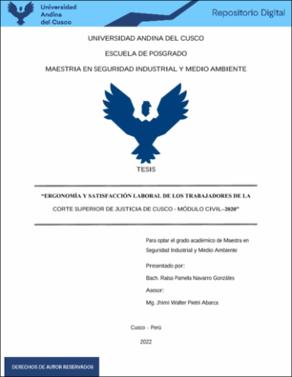| dc.contributor.advisor | Pietri Abarca, Jhimi Walter | |
| dc.contributor.author | Navarro Gonzáles, Raisa Pamela | |
| dc.date.accessioned | 2023-08-28T21:48:00Z | |
| dc.date.available | 2023-08-28T21:48:00Z | |
| dc.date.issued | 2022-11-03 | |
| dc.identifier.uri | https://hdl.handle.net/20.500.12557/5653 | |
| dc.description.abstract | El presente trabajo tiene por finalidad verificar la relación entre la ergonomía y la
satisfacción laboral de los trabajadores de la Corte Superior de Justicia de Cusco, ello a base de
la evaluación del puesto de trabajo, utilizando la variable ergonomía y satisfacción laboral.
Esta investigación tiene un enfoque Cuantitativo, con alcance correlacional. Se ha
empleado como técnica e instrumento las encuestas con preguntas estructuradas según las
variables, que en el caso de la Ergonomía se ha subdividido la misma en ergonomía geométrica,
ergonomía ambiental, ergonomía temporal y ergonomía cognitiva. De otro lado para la variable
satisfacción laboral se utilizó encuestas a los trabajadores a fin de obtener respuestas sobre su
perspectiva, ello a fin de relacionar las mismas variables mediante la estadística pertinente. Los
resultados muestran que: i) Sobre la ergonomía geométrica y la satisfacción laboral de los
trabajadores de la Corte Superior de Justicia cusco módulo civil 2020, se ha concluido que no
existe relación; ii) Respecto de la ergonomía ambiental y la satisfacción laboral de los
trabajadores de la Corte Superior de Justicia Cusco módulo civil 2020, se ha concluido que no
existe relación; iii) Sin embargo es importante resaltar que si existe relación entre la ergonomía
temporal y la satisfacción laboral de los trabajadores de la Corte Superior de Justicia Cusco
módulo civil 2020; iv) No existe relación entre la ergonomía cognitiva y la satisfacción laboral
de los trabajadores de la Corte Superior de Justicia Cusco módulo civil 2020. Por ende, se
concluye que no existe relación entre la ergonomía y la satisfacción laboral de los trabajadores la
Corte Superior de Justicia Cusco pese a que una de las dimensiones si se concluyó la existencia
de vinculación, dicha investigación podrá ser utilizada como premisa para otras investigaciones
dentro de entidades del Estado | es_PE |
| dc.description.abstract | The purpose of this work is to verify the relationship between ergonomics and job
satisfaction of the workers of the Superior Court of Justice of Cusco, based on the evaluation of
the job, using the variable ergonomics and job satisfaction.
This research has a quantitative approach, with a correlational scope. Surveys with
questions structured according to the variables have been used as a technique and instrument,
which in the case of Ergonomics has been subdivided into geometric ergonomics, environmental
ergonomics, temporal ergonomics and cognitive ergonomics. On the other hand, for the job
satisfaction variable, surveys of workers were used in order to obtain answers about their
perspective, in order to relate the same variables through the relevant statistics. The results show
that: i) Regarding the geometric ergonomics and the job satisfaction of the workers of the
Superior Court of Justice Cusco civil module 2020, it has been concluded that there is no
relationship; ii) Regarding environmental ergonomics and job satisfaction of the workers of the
Superior Court of Justice Cusco civil module 2020, it has been concluded that there is no
relationship; iii) However, it is important to highlight that there is a relationship between
temporary ergonomics and job satisfaction of the workers of the Superior Court of Justice Cusco
civil module 2020; iv) There is no relationship between cognitive ergonomics and job
satisfaction of the workers of the Superior Court of Justice Cusco civil module 2020. Therefore,
it is concluded that there is no relationship between ergonomics and job satisfaction of the
workers of the Superior Court of Justice. Justice Cusco despite the fact that one of the
dimensions if the existence of a link was concluded, said investigation may be used as a premise
for other investigations within State entities. | en_US |
| dc.format | application/pdf | es_PE |
| dc.language.iso | spa | es_PE |
| dc.publisher | Universidad Andina del Cusco | es_PE |
| dc.rights | info:eu-repo/semantics/openAccess | es_PE |
| dc.rights.uri | https://creativecommons.org/licenses/by-nc-nd/4.0/ | es_PE |
| dc.subject | Poder Judicial | es_PE |
| dc.subject | Ergonomía | es_PE |
| dc.subject | Satisfacción laboral | es_PE |
| dc.title | Ergonomía y satisfacción laboral de los trabajadores de la Corte Superior de Justicia de Cusco - Módulo Civil–2020 | es_PE |
| dc.type | info:eu-repo/semantics/masterThesis | es_PE |
| thesis.degree.name | Maestra en Seguridad Industrial y Medio Ambiente | es_PE |
| thesis.degree.grantor | Universidad Andina del Cusco. Escuela de Pos Grado | es_PE |
| thesis.degree.discipline | Seguridad Industrial y Medio Ambiente | es_PE |
| dc.publisher.country | PE | es_PE |
| dc.subject.ocde | https://purl.org/pe-repo/ocde/ford#2.11.04 | es_PE |
| renati.advisor.dni | 41435421 | |
| renati.advisor.orcid | https://orcid.org/0000-0002-2820-7148 | es_PE |
| renati.author.dni | 46358835 | |
| renati.discipline | 022247 | es_PE |
| renati.juror | Chuquimia Hurtado, Arturo | |
| renati.juror | Cavero Pacheco, Shaili Julie | |
| renati.juror | Delgado Obando, Jannette | |
| renati.juror | Villasante Lindo, Julio Alberto | |
| renati.level | https://purl.org/pe-repo/renati/level#maestro | es_PE |
| renati.type | https://purl.org/pe-repo/renati/type#tesis | es_PE |




